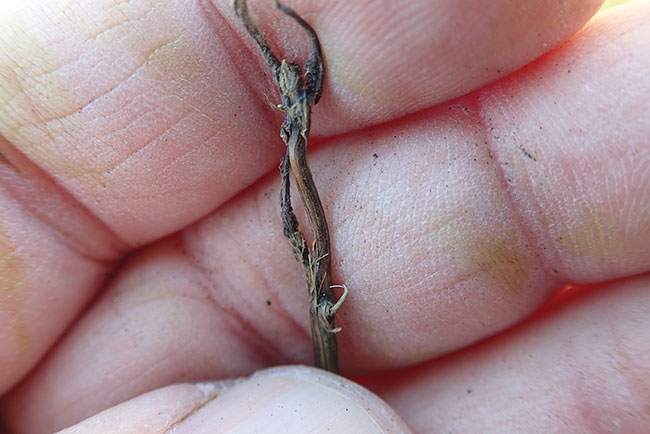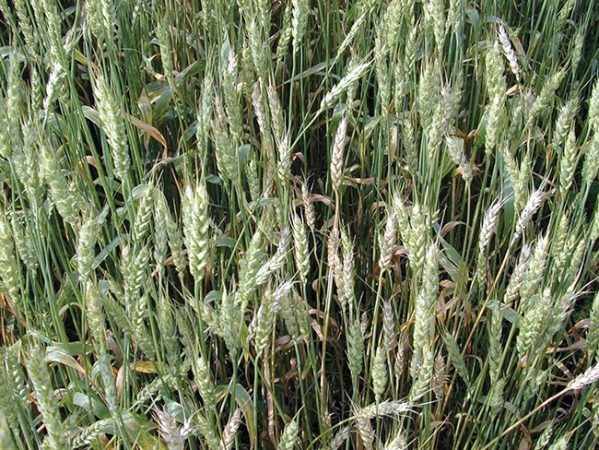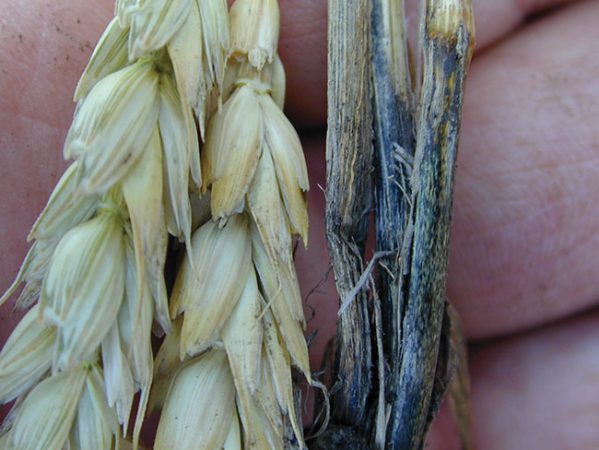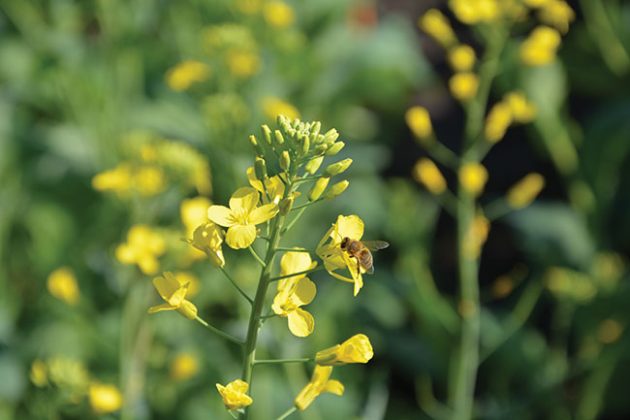
Features
Cereals
Diseases
Take-all in cereals
Cases of take-all may be low, but with the right conditions, this disease can still pose a problem.
May 12, 2021 By Julienne Isaacs
 Take-all infection can cause near-complete destruction of the root system and blackish discolouration. Photos courtesy of Kelly Turkington.
Take-all infection can cause near-complete destruction of the root system and blackish discolouration. Photos courtesy of Kelly Turkington. In the mid-to-late 1990s, when Kelly Turkington was new to the job as a pathologist for Agriculture and Agri-Food Canada, he remembers getting called out to fields with Bill Chapman, a specialist for Alberta Agriculture.
“We would encounter large patches in fields where something was wrong – the plants were shorter and prematurely ripened, and in many cases, there was very little root tissue left,” Turkington says.
The culprit was a disease of cereals caused by the fungal pathogen Gaeumannomyces graminis called take-all, so named for its devastating impact on the root system and stem base, which then affects the entire plant via reduced access to water and nutrients. When it’s a problem in a field, take-all can have a significant impact on yield – much greater than, say, common root rot, Turkington says.
If take-all is severe, plants will be stunted with charcoal-black stem and root system discolouration and disintegrated roots, such that plants can easily be pulled from the ground.
These days, Turkington doesn’t often get calls about take-all. It’s typically a problem in fields with continuous cereals or where wheat has been planted into grassland, he says. In a sense, take-all’s apparent disappearance from most producers’ radar is a good news story for the industry. The disease can be prevented via agronomic approaches that have become industry-standard.
But take-all hasn’t disappeared, and as there are no resistant varieties, it can still crop up for western Canadian producers if conditions are right. Here’s what to look for, and key management strategies to prevent take-all from gaining a foothold.
Disease effects and management
The take-all pathogen survives in hyphae in infected crop residues; plants become infected when healthy root systems contact infected residue during plant growth. Once infected, there may also be root-to-root spread via growth of runner hyphae of the take-all pathogen.
“The worst-case scenario is favourable conditions early, at the timing of seedling growth and early plant development, so the pathogen becomes established and progresses up through the root tissue and into the crown tissue and into the stem base,” Turkington says.
Once the disease destroys the root tissue, water and nutrient deficiencies cause premature ripening and stunting of the rest of the plant.
“Any healthy root tissue left cannot keep up with water and nutrient demands from the plant, especially if conditions become drier towards and during grain filling. So they’re stunted and very easy to see in the field, as small to large patches of plants may be affected,” Turkington says.
He adds that these types of symptoms and the appearance of affected patches of plants tend to occur during summers that are wet or in systems that rely on irrigation. Infection is typically limited in dry summers. “Most of the crop is fine, with the odd plant here and there that may be completely prematurely ripened,” he explains.
Turkington believes a combination of factors may be limiting take-all in western Canadian fields.
Diversifying crop rotations is the biggest factor, and the addition of canola to cereal rotations effectively breaks up the disease cycle. “Fields with canola see limited take-all,” Turkington says. If take-all is found in a field, a two-year gap in host plants is recommended, but even a single year of canola will go a long way to reducing take-all risk, he adds.
Pulses are also a good rotation choice, but even oats and rye present fewer potential problems with take-all than wheat or barley. Oat is affected by a different type of take-all pathogen, which doesn’t
affect wheat and other small grain cereals, Turkington explains.
“The other critical thing is to look at whether you’re controlling your volunteer wheat, which will carry the pathogen over between growing seasons,” he says.
Soil testing for micro and macronutrients is also key in preventing take-all; soils with copper, manganese, zinc, nitrogen, phosphorus, or potassium deficiencies are more vulnerable to infection. However, nutrient deficiencies may also result in poorer root growth, whereby balanced fertilization helps to promote root development, which may allow the plant to compensate even though it is affected by take-all, Turkington says. Nutrient deficiencies in the soil tend to work like a “dimmer switch” rather than an “on-off switch,” and soils that are deficient in one or more of these nutrients will be more vulnerable to take-all.
Turkington adds that lime, which is often added to soils as part of a clubroot management strategy, can increase the risk of take-all, which becomes more severe in neutral or alkaline soils.
Seed treatments can limit early season infections, but benefits have tended to be limited and variable with suppression at best, Turkington says. This may be related to shifts in the fungicides available as older, more effective products such as those containing triadimenol are no longer on the market. Another issue is that, for some fungicide actives, there may be more movement into seedling leaf and shoot tissues versus root tissue, which limits their efficacy.
He believes the move toward conservation tillage and the adoption of direct seeding may have helped deter take-all, creating a more biodynamic soil environment that speeds up infected residue decomposition and creates a more vibrant soil microbial environment that helps to limit the take-all pathogen.
Producers can find scouting and disease risk information from the Prairie Crop Disease Monitoring Network (PCDMN) in-season. Find them on twitter at @pcdmn. Scouting tips can be found on the PCDMN blog at prairiecropdisease.blogspot.com.


